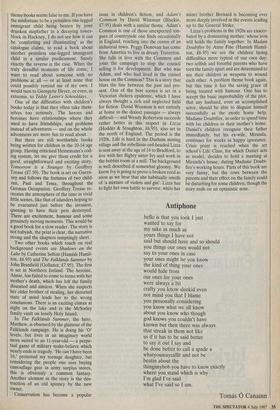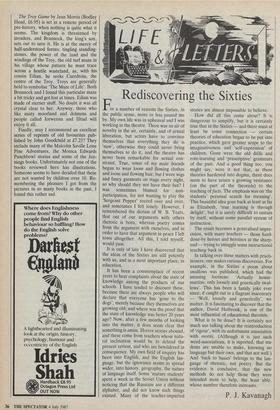Relationships and problems for children
Juliet Townsend Looking through a recent Heinemann Children's Books Catalogue, I was amused to see that the compilers had adopted a method of coding to describe their wares. Books illustrating 'the multi-cultural pers- pective' sport an 'M', and 'problem theme books' a somewhat negative 'X'. Problems, we are told, include `the uncertainties of adolescence, boy/girl relationships and those between teenager and parent/ authority/society; loneliness, truancy, health . . .' (surely this is more of a blessing than a problem?) '. . . unemploy- ment, obesity, the death of parent or friend.' Presumably these symbols are de- signed to help school librarians and other buyers who are unable or unwilling to read the books for themselves. One can happily employ an idle hour wandering through the groves of English literature, coding pencil in hand. Dickens is a fertile field for 'Xs', every single problem can be found, even the Fat Boy, confronting with sublime indifference the trauma of obesity. Shakespeare is just as good. Romeo and Juliet certainly qualify under 'boy/girl rela- tionships and those between teenager and parent/authority/society' and perhaps Blake can score an 'M' for The Little Black Boy.
The whole idea of therapeutic problem theme books seems false to me. If you have the misfortune to be a penniless one-legged immigrant child being beaten by your drunken stepfather in a decaying tower- block in Hackney, I do not see how it can be 'comforting and illuminating' as the catalogue claims, to read a book about another penniless one-legged immigrant child in a similar predicament. Surely exactly the reverse is the case. When the truly dreadful moments of life come, I want to read about someone with no problems at all — or at least none that could possibly remind me of my own. I would turn to Georgette Heyer, or even, in extremis, to Teddy Lester's Schooldays.
One of the difficulties with children's books today is that they often take them- selves too seriously. The heroes and heroines have relationships where they used to have friendships, and problems instead of adventures — and on the whole adventures are more fun to read about.
But there are still worthwhile books being written for children in the 10-14 age group. Having criticised Heinemann's cod- ing system, let me give them credit for a good, straightforward and exciting story, Tomorrow is a Stranger by Geoffrey Trease (0.50). The book is set on Guern- sey and follows the fortunes of two child- ren, Paul and Tessa, throughout the German Occupation. Geoffrey Trease re- creates the atmosphere of the time in vivid little scenes, like that of islanders hoping to be evacuated just before the invasion, queuing to have their pets destroyed. There are excitement, humour and some genuinely moving moments. This would be a good book for a slow reader. The story is not babyish, the print is clear, the narrative strong and the chapters temptingly short.
Two other books which touch on real background events are Shadows on the Lake by Catherine Sefton (Hamish Hamil- ton, £6.95) and The Falklands Summer by John Branfield (Gollancz, £7.95). The first is set in Northern Ireland. The heroine, Annie, has failed to come to terms with her mother's death, which has left the family disunited and aimless. When she suspects her older brother of stealing, her distorted state of mind leads her to the wrong conclusions. There is an exciting climax at night on the lake and in the McSorley family vault on lonely Holy Island.
In The Falklands Summer, the hero, Matthew, is obsessed by the glamour of the Falklands campaign. He is doing his '0' levels, but lives in an imaginary world more suited to an 11-year-old — a perpe- tual game of military make-believe which nearly ends in tragedy. 'He can't have been 16,' protested my teenage daughter, but considering the people one sees buying camouflage gear in army surplus stores, this is obviously a common fantasy. Another element in the story is the des- truction of an old spinney by the new owner.
Conservation has become a popular issue in children's fiction, and Adam's Common by David Wiseman (Blackie, £7.95) deals with a similar theme. Adam's Common is one of those unexpected ton- gues of countryside one finds occasionally in England, reaching into the centre of an industrial town. Peggy Donovan has come from America to live in dreary Traverton. She falls in love with the Common and joins the campaign to stop the council selling it for development. But who was Adam, and who had lived in the ruined house on the Common? This is a story that blurs the line between the past and pre- sent. One of the best scenes is set in a Victorian cholera epidemic, which I have always thought a rich and neglected field for fiction. David Wiseman is not entirely at home in the dialect passages — always difficult — and Wendy Robertson succeeds rather better in this respect in Lizza (Hodder & Stoughton, £6.95), also set in the north of England. The period is the 1920s. Life is hard in the Durham mining village and the rebellious red-headed Lizza is sent away at the age of 14 to Bradford, to live with her flighty sister Ivy and work in the bobbin room at a mill. The background is well described if somewhat gloomy. We know Ivy is going to prove a broken reed as soon as we hear that she habitually smells of 'a mixture of violets and gin'. Lizza has to fight her own battle to survive, while her miner brother Bernard is becoming ever more deeply involved in the events leading up to the General Strike.
Lizza's problems in the 1920s are exacer- bated by a dominating mother, whose iron will holds the family together. In Madam Doubtfire by Anne Fine (Hamish Hamil- ton, £6.95) we see the children facing difficulties more typical of our own day: two selfish and forceful parents who have torn the family apart and are determined to use their children as weapons to wound each other. A problem theme book again, but this time it has the saving grace of being treated with humour. One has to accept the basic improbability of the plot, that any husband, even an accomplished actor, should be able to disguise himself successfully as the exotic home help, Madame Doubtfire, in order to spend time with his children in their mother's home. Daniel's children recognise their father immediately, but his ex-wife, Miranda, continues for weeks in happy ignorance. Crisis point is reached when the art school's Life Class, for which Daniel acts as model, decides to hold a meeting at Miranda's house, during Madame Doubt- fire's working hours. Parts of this book are very funny, but the rows between the parents and their effect on the family could be disturbing for some children, though the story ends on an optimistic note. The Troy Game by Jean Morris (Bodley Head, £6.95) is set in a remote period of pre-history, when nothing is quite what it seems. The kingdom is threatened by invaders, and Brannock, the king's son, sets out to save it. He is at the mercy of half-understood forces: tingling standing- stones, the power of the land and the windings of the Troy, the old turf maze in his village whose pattern he must trace across a hostile wasteland, as, with his cousin Eilian, he seeks Caerdroia, the centre of the Troy. Troys are generally held to symbolise 'The Maze of Life'. Both Brannock and I found this particular maze a bit tricky and got lost at times. Eilian was made of sterner stuff. No doubt it was all crystal clear to her. Anyway, those who like misty moorland and dolmens and people called lorwenna and Illtud will enjoy it all. Finally, may I recommend an excellent series of reprints of old favourites pub- lished by John Goodchild at £7.25? They include many of the Malcolm Saville Lone Pine Adventures, the Monica Edwards Punchbowl stories and some of the Jen- nings books. Unfortunately not one of the books reviewed here has illustrations. Someone seems to have decided that these are not wanted by children over 10. Re- membering the pleasure I got from the pictures in so many books in the past, I found this rather sad.




















































 Previous page
Previous page